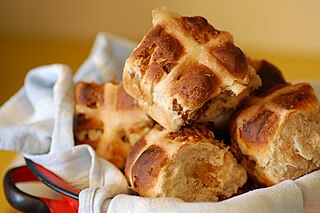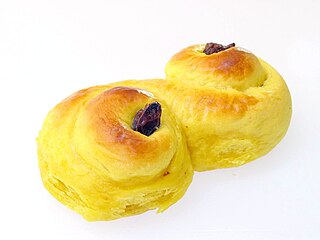| Alternative names | Penny loaf |
|---|---|
| Type | Bread |
| Place of origin | England |
A penny bun or a penny loaf was a small bread bun or loaf which cost one old penny at the time when there were 240 pence to the pound. A penny loaf was a common size loaf of bread in England regulated by the Assize of Bread and Ale act of 1266. The size of the loaf could vary depending on the prevailing cost of the flour used in the baking. [1] The nursery rhyme London Bridge Is Falling Down has a version which includes the line "Build it up with penny loaves". [2]
The term appears in the first complete published version of the "To Market, To Market" rhyme in 1805 as "To market, to market, to buy a penny bun, Home again, home again, market is done" in Songs for the Nursery. [3]
The expression "penny bun" is Cockney rhyming slang for one, sun and son. [4] "Penny bun" is also the common English name for the cep (French), or Boletus edulis , an edible basidiomycete mushroom. Native to Europe and North America, it is Europe's second most sought-after fungus after truffles. [5]
"Cockle to a penny bun" is British slang for racing odds of 10 to 1. [4]

Rhyming slang is a form of slang word construction in the English language. It is especially prevalent among Cockneys in England, and was first used in the early 19th century in the East End of London; hence its alternative name, Cockney rhyming slang. In the US, especially the criminal underworld of the West Coast between 1880 and 1920, rhyming slang has sometimes been known as Australian slang.

Humpty Dumpty is a character in an English nursery rhyme, probably originally a riddle and one of the best known in the English-speaking world. He is typically portrayed as an anthropomorphic egg, though he is not explicitly described as such. The first recorded versions of the rhyme date from late eighteenth-century England and the tune from 1870 in James William Elliott's National Nursery Rhymes and Nursery Songs. Its origins are obscure, and several theories have been advanced to suggest original meanings.

Baking is a method of preparing food that uses dry heat, typically in an oven, but can also be done in hot ashes, or on hot stones. The most common baked item is bread, but many other types of foods can be baked. Heat is gradually transferred "from the surface of cakes, cookies, and pieces of bread to their center, typically conducted at elevated temperatures surpassing 300°F. Dry heat cooking imparts a distinctive richness to foods through the processes of caramelization and surface browning. As heat travels through, it transforms batters and doughs into baked goods and more with a firm dry crust and a softer center. Baking can be combined with grilling to produce a hybrid barbecue variant by using both methods simultaneously, or one after the other. Baking is related to barbecuing because the concept of the masonry oven is similar to that of a smoke pit.

A hot cross bun is a spiced bun, usually containing small pieces of fruit and marked with a cross on the top, which has been traditionally eaten on Good Friday in the United Kingdom, Ireland, Australia, New Zealand, South Africa, Canada, India, Pakistan, Malta, United States and the Commonwealth Caribbean. They are available all year round in some countries, including the UK.

Boletus edulis is a basidiomycete fungus, and the type species of the genus Boletus. Widely distributed in the Northern Hemisphere across Europe, Asia, and North America, it does not occur naturally in the Southern Hemisphere, although it has been introduced to southern Africa, Australia, New Zealand, and Brazil. Several closely related European mushrooms formerly thought to be varieties or forms of B. edulis have been shown using molecular phylogenetic analysis to be distinct species, and others previously classed as separate species are conspecific with this species. The western North American species commonly known as the California king bolete is a large, darker-coloured variant first formally identified in 2007.

Bunny chow, often referred to simply as a bunny, is an Indian South African fast food dish consisting of a hollowed-out loaf of white bread filled with curry and a serving of salad on the side. It originated among Indian South Africans of Durban. Throughout various South African communities, one can find cultural adaptations to the original version of the bunny chow, which uses only a quarter loaf of bread and is sometimes called a skhambane,kota ("quarter") or shibobo, a name it shares with sphatlho, a South African dish that evolved from the bunny chow.
Hot Cross Buns was an English street cry, later perpetuated as a nursery rhyme and an aid in musical education. It refers to the spiced English confection known as a hot cross bun, which is associated with the end of Lent and is eaten on Good Friday in various countries. The song has a Roud Folk Song Index number of 13029.

A saffron bun, Cornishtea treat bun or revel bun, is a rich, spiced yeast-leavened sweet bun that is flavoured with saffron and contains dried fruit including currants and raisins similar to a teacake. The main ingredients are plain flour, butter, yeast, caster sugar, currants and sultanas. Larger versions baked in a loaf tin are known as saffron cake.
The Assize of Bread and Ale was a 13th-century law in high medieval England, which regulated the price, weight and quality of the bread and beer manufactured and sold in towns, villages and hamlets. It was the first law in British history to regulate the production and sale of food. At the local level, this resulted in regulatory licensing systems, with arbitrary recurring fees, and fines and punishments for lawbreakers. In rural areas, the statute was enforced by manorial lords, who held tri-weekly court sessions.

Boletus is a genus of mushroom-producing fungi, comprising over 100 species. The genus Boletus was originally broadly defined and described by Carl Linnaeus in 1753, essentially containing all fungi with hymenial pores instead of gills. Since then, other genera have been defined gradually, such as Tylopilus by Petter Adolf Karsten in 1881, and old names such as Leccinum have been resurrected or redefined. Some mushrooms listed in older books as members of the genus have now been placed in separate genera. These include such as Boletus scaber, now Leccinum scabrum, Tylopilus felleus, Chalciporus piperatus and Suillus luteus. Most boletes have been found to be ectomycorrhizal fungi, which means that they form a mutualistic relationship with the roots system of certain kinds of plants. More recently, Boletus has been found to be massively polyphyletic, with only a small percentage of the over 300 species that have been assigned to Boletus actually belonging there and necessitating the description and resurrection of many more genera.

Boletus aereus, commonly known as the dark cep, bronze bolete, or queen bolete, is a highly prized and much sought-after edible mushroom in the family Boletaceae. The bolete is widely consumed in Spain, France, Italy, Greece, and generally throughout the Mediterranean. Described in 1789 by French mycologist Pierre Bulliard, it is closely related to several other European boletes, including B. reticulatus, B. pinophilus, and the popular B. edulis. Some populations in North Africa have in the past been classified as a separate species, B. mamorensis, but have been shown to be phylogenetically conspecific to B. aereus and this taxon is now regarded as a synonym.

Neoboletus luridiformis, also previously known as Boletus luridiformis and (invalidly) as Boletus erythropus, is a fungus of the bolete family, all of which produce mushrooms with tubes and pores beneath their caps. It is found in Northern Europe and North America, and is commonly known as the scarletina bolete, for its red pores, which are yellow when young. Other common names include the red foot bolete, dotted stemmed bolete, or dotted stem bolete.

Boletus reticulatus, and commonly referred to as the summer cep is a basidiomycete fungus of the genus Boletus. It occurs in deciduous forests of Europe, where it forms a symbiotic mycorrhizal relationship with species of oak (Quercus). The fungus produces fruiting bodies in the summer months which are edible and popularly collected. The summer cep was formally described by Jacob Christian Schäffer as Boletus reticulatus in 1774, which took precedence over B. aestivalis as described by Jean-Jacques Paulet in 1793.
"To Market, To Market" or "To Market, To Market, to Buy a Fat Pig" is a folk nursery rhyme which is based upon the traditional rural activity of going to a market or fair where agricultural produce would be bought and sold. It has a Roud Folk Song Index number of 19708.

Boletus pinophilus, commonly known as the pine bolete or pinewood king bolete, is a basidiomycete fungus of the genus Boletus found throughout Europe and western Asia. Described by Italian naturalist Carlo Vittadini in 1835, B. pinophilus was for many years considered a subspecies or form of the porcini mushroom B. edulis before genetic studies confirmed its distinct status. In 2008, B. pinophilus in western North America were reclassified as a new species, B. rex-veris. B. pinophilus is edible, and may be preserved and cooked.

"Ride a Cock Horse to Banbury Cross" is an English language nursery rhyme connected with the English town Banbury in Oxfordshire. It has a Roud Folk Song Index number of 21143.